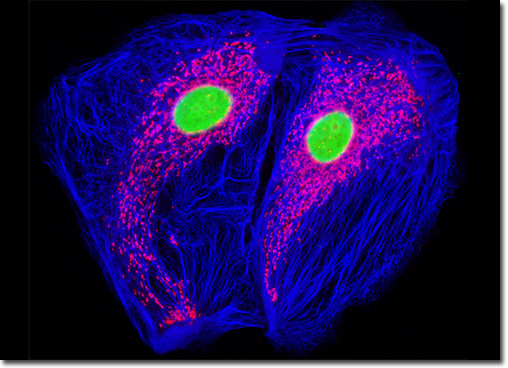Fluorescence Digital Image Gallery
Pig Kidney Epithelial Cells (LLC-PK1)
|
In order to prevent the human body from rejecting porcine organs, the pigs they are derived from must be genetically modified. Researchers have already experienced considerable success in this regard, baboon subjects living for substantial time periods after receiving kidneys of pigs modified so that they lack a certain sugar molecule that normally induces the monkey and human immune systems to aggressively attack any foreign tissues. Yet, despite such advances, there may be significant obstacles to overcome along the path to widely accepted xenotransplantation. For instance, a number of ethical issues must be addressed and there is already rising concern about the possibility of virus transference between species. In fact, some studies suggest that porcine endogenous retrovirus (Perv), which is present in the pig genome, is shed by porcine kidney cells, such as those of the LLC-PK1 line, and can infect humans. These findings conflict with some other research reports, however, and are being hotly contested in the scientific community. The digital image presented above features a culture of pig kidney cells that was immunofluorescently labeled primary anti-cytokeratin (pan) mouse monoclonal antibodies followed by goat anti-mouse Fab fragments conjugated to Marina Blue. The cells were also labeled with MitoTracker Red CMXRos and SYTOX Green, targeting the intracellular mitochondrial network and DNA, respectively. Images were recorded in grayscale with a QImaging Retiga Fast-EXi camera system coupled to an Olympus BX-51 microscope equipped with bandpass emission fluorescence filter optical blocks provided by Omega Optical. During the processing stage, individual image channels were pseudocolored with RGB values corresponding to each of the fluorophore emission spectral profiles. |
© 1995-2025 by Michael W. Davidson and The Florida State University. All Rights Reserved. No images, graphics, software, scripts, or applets may be reproduced or used in any manner without permission from the copyright holders. Use of this website means you agree to all of the Legal Terms and Conditions set forth by the owners.
This website is maintained by our
|
